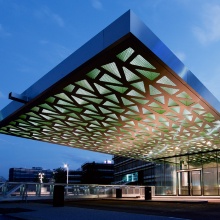How should we face the effects of megatrends such as digital transformation, sustainable production, demographic change, and environmentally friendly mobility concepts in the Stuttgart region and in the companies located there? Concepts for these challenges are being developed by the new Industrial Construction working group at the University of Stuttgart – which also includes renowned companies in the vicinity – for the IBA 2027 International Building Exhibition in the Stuttgart region. The panel is now presenting its initial deliberations in a position paper.
The representatives of the Industrial Construction working group include not only the University of Stuttgart's Industrial Real Estate Management (IREM) department, but also renowned companies in the vicinity. The goal of the group is the future-oriented development of industry-related culture to secure prosperity in the Stuttgart region. The members intend to
- understand digital transformation as a requirement to remain internationally competitive and sustainable and will actively shape this;
- develop new mobility concepts for sustainable living using innovative ideas and generating new products and business models;
- face the challenges of artificial intelligence to cooperate in designing changes for the benefit of society;
- take demographic change into account in their work environments; and
- face new requirements for sustainability with more resource-efficient, responsible actions.
Prior to the International Building Exhibition 2027 in Stuttgart, the panel intends to develop initial concepts and implement measures.
Focus on existing properties
The main foci of the working group will include new concepts for existing properties and the responsible use of natural resources. These issues are particularly controversial in urban areas because different types of land use are involved and because industrial and commercial sites are in short supply. The Stuttgart vicinity is also faced with a strong demand for scarce properties and high land prices. This problem can not be solved merely by changing the allocation of land, especially since such land is barely available.
One of the ideas of the working group for the conversion of existing properties is that low-emission, space-saving production facilities could arise in the immediate vicinity of a residential area, thus significantly increasing the quality of life and work for the residents.
Responsible use of natural resources
Another concern of the working group, particularly in the light of the recent scandal involving exhaust emissions manipulation, is the responsible use of natural resources. Due to the powerful automotive and supplier industries, companies in the area of Stuttgart have a special responsibility for this. The companies have set themselves the goal of uniting economic and ecological activities. The goals are to show how natural resources can be saved despite higher productivity and how to set high energy standards. Especially cities such as Stuttgart, where air pollution affects the quality of life, benefit from these measures.
The objectives of the Industrial Construction working group are supported by all its members:
- Andreas Stihl AG & Co. KG
- Drees & Sommer
- Flughafen Stuttgart GmbH
- Ingenieurgemeinschaft Gölkel IGG
- Kohlbecker Plan GmbH
- Mann + Hummel GmbH
- Orange Blu building solutions GmbH & Co. KG
- Robert Bosch GMBH
- Strähle Space Systems GmbH
- Trumpf GmbH + Co. KG
- University of Stuttgart, Industrial Real Estate Management (IREM)
Expert Contact:
Prof. Christian Stoy, University of Stuttgart, Institute of Construction Economics, Tel. +49 711 68 58 33 09, Mail


